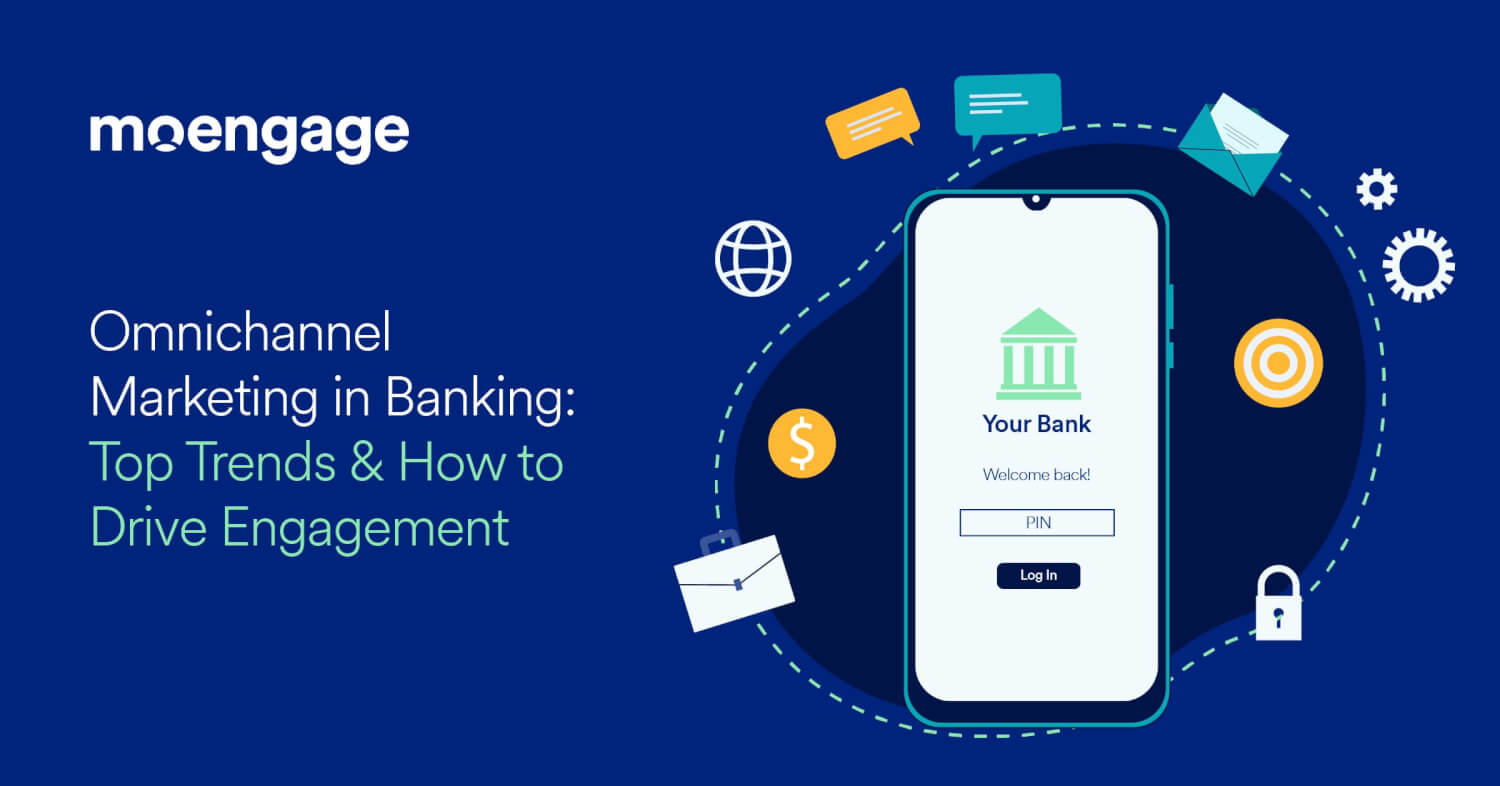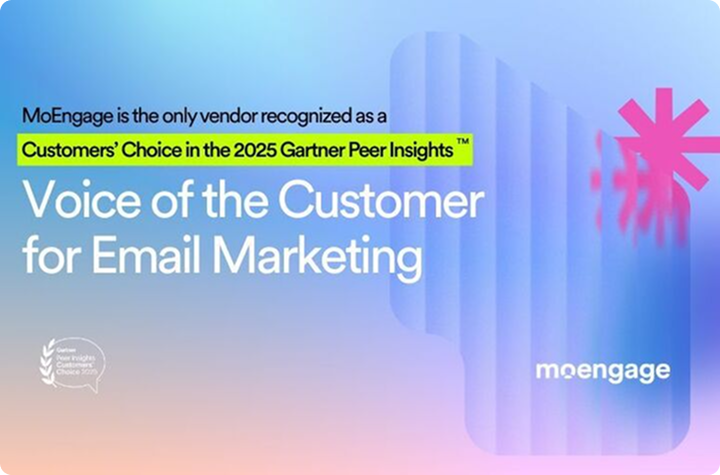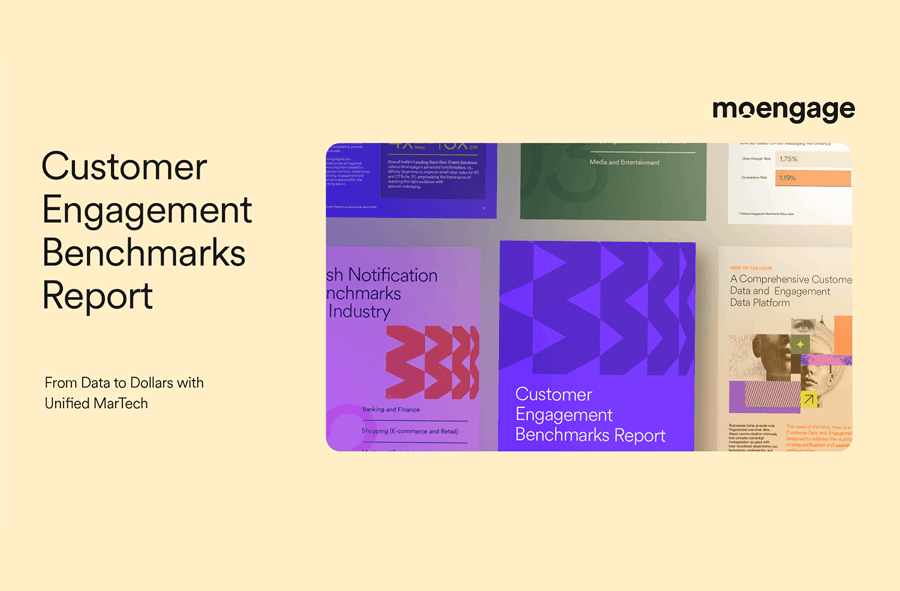Omnichannel Marketing in Banking: Top Trends & How to Drive Engagement
Learn how to acquire, engage, retain, and reactivate banking customers by building omnichannel customer experiences.

Reading Time: 13 minutes
The use of digital banking has not only risen in recent years, it’s become a staple of the banking process for most consumers — and an important feature when customers choose a bank to work with.
eMarketer reports that 89% of consumers use mobile banking. There is even greater penetration in younger customer segments, with 97% of millennials claiming they use mobile banking in some capacity.
To survive and succeed in the modern financial industry, banks must connect their brick-and-mortar locations with digital experiences, and prioritize creating omnichannel customer experiences.
While many banks have adopted digital channels, these are often multichannel systems that are disjointed, lack integration, and fail to deliver the quality of service modern customers look for.
In banking, an omnichannel marketing strategy aims to connect all these disjointed channels, creating an integrated, cohesive system where all channels work in unison to provide customers a seamless experience across all touchpoints.
To help financial marketers perfect their omnichannel strategy, we discuss top omnichannel trends, unavoidable challenges (and how to overcome them), and best practices to follow in this article.
What is Omnichannel Marketing in Banking?
Omnichannel marketing in banking is a customer engagement strategy that involves creating a seamless experience for customers regardless of the channel they use. It involves integrating online and offline channels to deliver personalized, targeted marketing campaigns and experiences for customers.
Accessible digital banking is important, but curating a customer-focused experience requires every channel — online and off — to be convenient and engaging to the customer at all times.
Customers navigate their banking systems and access financial services dynamically; they switch back and forth from channel to channel. Unifying these disparate channels to create a seamless, convenient, and consistent experience for customers proves that you’re dependable, reliable, and relatable.
Implementing strict customer-experience guidelines will improve consistency in the customer journey. Bridging communication silos and dismantling data isolation are the first steps to transitioning from a multi-channel approach to an omnichannel strategy.
The goal is to be able to deliver contextual information that is relevant to the customer’s prior touchpoints at any stage and from any channel.
In order to effectively implement an omnichannel strategy, banks need to be informed on emerging omnichannel marketing trends that can help in elevating the customer banking experience.
4 Omnichannel Banking Trends: Current State of the Digital Banking Experience
Since the new millennium, convenience has become king.
Currently, ease of use reigns supreme, with customers demanding fast, seamless experiences that save them time and simplify their lives. Expectedly, most omnichannel banking trends revolve around the idea of making customer experiences easy, accessible, and convenient.
Below, we explore the current state of cross-channel marketing in the banking industry in more detail to help you understand why omnichannel is essential and help you navigate this shift.
1. Rise of Fintechs has changed the modern banking landscape
The rise of Fintechs in the last decade has drastically changed customer expectations for their banking and financial needs.
After all, Fintechs have carved out market share by offering customers a mobile-first, digital banking experience that prioritizes convenience, makes access easier, and ensures all marketing and transaction communication is in sync.
In turn, modern customers have come to expect simple, accessible, and intuitive experiences that connect them to all their financial service needs and communications in one platform.
Modern banking is now increasingly digital, with more customers using mobile apps to manage regular, routine tasks.
This means most banks now rely on their mobile app — and mobile devices in general — as their main means of communication with their customers, saving customers time from visiting a branch and waiting in line.
The result is customers who want access to instant, accessible, and convenient financial services and communication. This shift has made omnichannel marketing in banking more important than ever, as it’s the most effective way to connect with customers.
2. A customer-centric approach is vital for success
Modern customer engagement isn’t about inundating customers with messaging across all their channels, it’s about curating customer-centric experiences that are built around — and serve — your customers’ unique needs.
Banks looking to optimize engagement and improve retention will want to build an omnichannel strategy that puts customers first, helping them easily meet customer’s diverse needs.
At the end of the day, every time you communicate with your customer, they should feel like you know who they are and that you’re there to support them on their journey to financial success.
By placing customers at the center of the experience, you drastically increase their satisfaction, drive engagement, and establish long-term brand loyalty.
A customer-centric approach to customer experience is no longer nice to have, it’s a necessity in the modern financial landscape. The fact is, customers expect the same quality of experience and depth of personalization from their financial provider as they get from Netflix.
3. Instant payments require instant communication
The widespread adoption of digital banking has led to faster payments, to the point that payments can now take place in real time. But for the entire customer experience to be seamless, customers need instant communication to come with it.
Specifically, for banks to keep customers happy, they need to provide real-time communication that keeps pace with their services. Being able to alert on transactions and service updates instantly is crucial for ensuring customer satisfaction and building trust.
Without prompt notifications about account activity and timely offers that customers can take advantage of, they’ll quickly lose favor with your brand and opt for competitors that can provide a better experience.
Banks looking to stand out will need to build intuitive transactional messaging campaigns that keep customers informed and in the loop as soon as any key banking/transactional activity happens.
4. AI-driven automation and optimization
In an industry known for its slow pace, AI automation presents exceptional opportunities for omnichannel marketers in the banking sector.
The recent development of providing customers with instant support and efficient answers to their questions stands to elevate the customer experience overall.
AI optimization helps marketers capitalize on resources and maximize productivity, saving banks resources in the process.
AI empowers omnichannel marketers to automate repetitive tasks, streamline workflows, conduct A/B testing in real time, and improve productivity, allowing them to focus on their overall strategy and campaign development.
This goes beyond campaigns as well; banks can streamline and automate customer support tasks by employing chatbots that dynamically learn and improve their ability to handle service requests.
If you want more information on the state of the omnichannel banking market, check out our full list of 8 omnichannel banking trends here.
Why Take an Omnichannel Banking Approach to Customer Engagement?
In an industry where it’s hard to develop consumer trust, acquire customers, and convince them to stick with your brand, customer engagement in banking is more important than ever.
After all, it’s engagement that gets customers to sign up, invest their money, and expand their financial portfolios.
Below, we look at the main reasons an omnichannel marketing strategy is essential for banks.
- Meet customers where they are: Connect with customers using their preferred channels, timing, and message frequency to improve open rates and engagement. Give them valuable information and connect them to relevant offers to keep them coming back.
- Deliver hyper-personalized experiences: Improve traction and foster engagement by providing personalized experiences that customers resonate with. Prove you understand their financial needs and deliver targeted messaging that helps them navigate their journey toward financial success.
- Increase conversions and investment: Customers who receive an impressive banking experience and communication will continue to use services, buying other financial products and increasing their investments with the FI.
- Become customers’ primary financial institution: By connecting with customers over their preferred channel and building a best-in-class experience, banks are able to increase retention, foster brand loyalty, and establish themselves as their customers’ primary financial institution.
Ultimately, omnichannel marketing is all about offering targeted, personalized marketing campaigns that leverage relevant channels.
The reason it’s so effective is that it helps banks connect with their customers and offer a personal touch, fostering loyalty that translates into increased financial investment and ultimately a greater customer lifetime value.
How to Master Omnichannel Marketing in Banking to Improve Customer Engagement
Modern shifts in financial consumer behavior mean that engaging with customers in the banking industry is no longer very different from engaging customers in other industries.
Customers want the same level of convenience and personalization they get from shopping and lifestyle services and apps. For banks to stand out, they need to offer best-in-class experiences to their customers.
However, one of the biggest differences in the financial sector is that customers are far more cautious about choosing, switching to, and more heavily investing their money in a product or service than they are in other industries.
This makes it harder to acquire customers and maintain long-lasting relationships, requiring brands to spend more time building each individual customer’s trust.
The following strategies and best practices will help marketers leverage an omnichannel strategy effectively in the banking industry to build customer trust and increase engagement.
1. Root your decisions in deep customer insights and analytics
Comprehensive data leads to better decision-making. Omnichannel data provides a complete, holistic picture of your customers so you can make fast, efficient decisions that deliver results.
When you have enough customer data, you can segment your customers and group cohorts with confidence.
Leverage omnichannel insights to inform how you choose the content, channel, and timing of messages to squeeze the most out of your omnichannel marketing strategy and connect with your customers.
Deep insights are incredibly important for crafting and optimizing your customer experience to maximize engagement.
Assess your omnichannel data to determine where churn occurs, develop campaigns to prioritize reactivating lost customers, and enable push notifications and other marketing communication to engage customers who could be on the verge of abandoning your institution for another banking provider.
2. Segment customers and develop accurate buyer personas
To properly leverage an omnichannel strategy, banks must deliver the right content, over the right channel, at the right time. To get this right, they need to understand their customers so they can deliver targeted, personalized campaigns that resonate with them.
Brands that are able to accurately segment their customers are better equipped to hone in on the optimal channel to use for different types of messages, as well as personalize the content and timing of these messages to increase traction.
Better customer segmentation allows you to create campaigns that resonate with your customers, allowing you to make them feel personally appreciated and valued.
Showing your customers you understand them builds trust and instills confidence in your brand. This leads to greater engagement, more product sales, and more investment at your institution from customers.
3. Use real-time service and transactional alerts to keep customers informed
Banking and financial services customers expect immediate communication that keeps them apprised of their financial accounts in real-time, so they have up-to-date, accurate information on their personal finances.
More than that, this helps many customers feel a lot more at ease about the security of their finances.
Use an omnichannel strategy to provide bank customers real-time transactional alerts that inform, engage, and activate customers.
Send transaction and account confirmations, recommend relevant financial products, and convince them to invest more of their funds at your institution. Leverage automated messages to keep customers informed of their banking activity in real time, improve account security, build customer trust, and achieve customer satisfaction.
4. Develop seamless customer experiences that customers love
Customers are looking for Netflix-quality customer experiences that are convenient, familiar, and frictionless. They want brands that deeply understand their behavior and diligently meet their preferences.
Make sure customers can seamlessly transition between channels, and ensure that the experiences they have across these channels are consistent. Track every customer action and use that data to collect meaningful insights about your visitors so you can more effectively meet their needs and desires.
Deliver hyper-personalized campaigns that customers love and provide orchestrated journeys that save customers time and make their lives easier.
The result is a seamless, intuitive customer experience that more effectively anticipates and adapts to customer preferences, and therefore improves engagement and fosters long-term product loyalty.
Banks are all aiming to do the thing, and are increasingly turning to omnichannel marketing to create the experiences their customers expect.
5. Orchestrate customer journeys that foster engagement
Financial customers want to receive relevant communication based on where they are in their financial journey.
To maximize the value of all the channels you’re using in your omnichannel strategy, you need to be very thoughtful about where, when, and how you employ them throughout the customer journey and within your individual conversion funnels.
You also need to tailor the communication you use in your campaigns based on the customer’s journey stage.
Create intuitive customer journeys that guide visitors through conversion funnels, whether it’s lead generation, product sales, or further investment.
Also, by analyzing churn, you can see where customers are dropping off and identify friction points in the customer journeys and campaigns that cause customers to leave.
If you’re able to analyze these shortcomings and make timely improvements, you can keep customers satisfied and ensure retention.
6. Personalize experiences to optimize engagement
There are few things people consider more personal than their finances.
Banks need to offer their customers the same — if not greater — level of personalization that they get when shopping, ordering food, and streaming content. Modern financial customers want FIs that understand them and their financial needs, and that help them navigate the banking landscape and make good financial decisions.
With more channels at your disposal, you can be more particular about how you connect with customers.
Maximize engagement and improve satisfaction by crafting highly personalized web experiences and campaigns that connect customers with relevant products and services that have higher conversion rates and increase cross-sell and upsell opportunities.
7. Develop consumer trust (and brand loyalty)
Consumers keep their finances — and related personal information — close to the chest. For banks to onboard customers, sell financial products, and convince their customers to invest more of their money and assets at their institution, they need to build customer trust.
First off, customers are wary of sharing personal information required to sign on, making them harder to acquire in the first place.
By nature, the banking industry requires them to verify their customers are who they say they are, requiring them to perform more robust due diligence on newly onboarded customers.
This creates significant friction for new customers, friction that they don’t get in other industries. To excel, banks must reduce as much friction in the process as possible, making it easier for customers to onboard.
Beyond this, customers are constantly trusting their FIs with both financial and personal information. Brands need to ensure this data remains secure and private for their customers to instill a sense of trust.
They also need to be conscious of when, why, and how they use this entrusted information to communicate with customers.
Use omnichannel communication to assure customers that their financial transactions and information is safe and secure.
Provide timely updates via SMS, email, and mobile push to let customers know when a large purchase is made or an account password is changed.
When customers trust their FIs, they engage with the brand more, buy more financial products, and invest more of their money.
8. Power improvements with AI-driven optimization
When you have multiple customer journeys and marketing campaigns operating at any given time (using a myriad of channels), it’s very challenging to effectively analyze and improve each one individually.
AI-driven optimization empowers marketers to automate campaign improvements, working around the clock to perfect the delivery time, channel, tone, and substance of the messages in your campaigns.
When deployed properly, AI can help marketers better connect with customers and forge long-lasting relationships that improve traction and engage more customers.
5 Consumer Engagement Challenges in Omnichannel Banking and How MoEngage Solves Them
Making the transition to omnichannel marketing in banking requires careful consideration of the cross-channel marketing blind spots and challenges facing financial institutions. When planned for — and adequately addressed — these challenges can easily be solved.
Below, we look at some of the most common challenges banks face when looking to engage customers and (more importantly) explain how you can overcome them with a customer engagement platform (aka “CEP”) that helps you deliver omnichannel banking experiences.
1. Failure to fully embrace an omnichannel strategy
According to our recent survey, 33.3% of Financial Services marketers say their biggest channel with customer engagement is executing cross-channel communication.
To achieve success, an omnichannel strategy needs to have full buy-in from the start. It needs to permeate through all of your marketing efforts, influencing how you choose channels, how you orchestrate customer journeys, and how you craft individual campaigns.
All teams need to be on board and working together towards the same objectives. Democratize data across the organization and foster transparent communication so that all teams are operating in sync and omnichannel programs can be executed seamlessly.
A Customer Engagement Platform (CEP) like MoEngage makes executing omnichannel campaigns a breeze, with its hands-on interface, self-serve dashboards, and actionable insights.
2. Relying on siloed, unactionable data and analytics
According to our State of Cross-Channel Marketing for Financial Services brands article, when asked about their biggest customer engagement challenges, 32% of B2C Financial Services marketers answered data silos and 21.8% answered unactionable data.
And while this certainly means it’s on marketers’ radar, these still don’t rank high enough considering the impact poor data and inaccurate (or unactionable) insights can have on your omnichannel marketing campaigns.
Quite frankly, siloed data simply doesn’t work for an omnichannel strategy that requires marketers to have a holistic view of their customers and to gain clarity around channel effectiveness.
Since the entire point of omnichannel marketing is to not just offer the customer multiple points of interaction but to ensure these channels are integrated and operate seamlessly.
Integrated data allows marketers to create a holistic picture of their customers, which leads to meaningful actionable insights that allow brands to optimize their customer experience and improve engagement.
MoEngage knows that data powers your omnichannel strategy and gives you the ability to deliver hyper-personalized experiences that customers love.
That’s why we prioritize customer analytics, offering AI-powered insights that allow you to understand your customers and deliver seamless, omnichannel experiences.
3. Executing highly personalized experiences and messaging
42.9% of Financial Services marketers say their biggest channel with customer engagement is delivering personalized experiences.
Even when you have a lot of data at your disposal, developing and implementing highly personalized experiences and campaigns that resonate with different customer segments can be challenging, especially if you don’t have the right insights.
Getting any omnichannel strategy right relies heavily on personalization. After all, to leverage multiple channels effectively, you need to be able to communicate with the right content, over the right channel, for the right purpose, and at the right time.
All of these things can be extremely challenging to coordinate effectively, creating significant room for error.
Here at MoEngage, we don’t just help you get a clear picture of your customers’ behavior and habits, we also help you turn that information into meaningful insights that let you deliver personalized experiences that resonate with your customers.
4. Repetitive or irrelevant mobile engagement efforts
25.9% of Financial Services marketers say their biggest challenge with customer engagement is getting real-time analytics.
Omnichannel marketing that inundates customers with repetitive and irrelevant communication doesn’t actually help you, it frustrates customers and turns them away.
Without real-time insights, identifying weaknesses — let alone implementing changes — can take a long time. In the meantime, you’re delivering campaigns that really don’t resonate with your audience.
Delayed insights lead to delays in campaign optimization and necessary course corrections, which could cause you to fall short of customer expectations.
MoEngage offers real-time analytics and insights so your bank can quickly update and optimize campaigns to clamp down on customer dissatisfaction and mitigate churn before it happens.
5. Meeting security standards and data privacy compliance requirements
Data privacy and security are hot-button issues in today’s climate. These fears are only exacerbated for consumers in the financial sector. Data breaches and other security risks fuel customer concerns about the safety of their personal information and financial assets.
For financial service brands to succeed in acquiring customers and increasing engagement, they need to develop a strong sense of trust with their customers.
MoEngage meets security standards and complies with all data privacy regulations (including GDPR and CCPA) so you keep your customers protected and can build on a foundation of trust and safety.
We work with multiple leading Customer Data Platforms (CDPs): Tealium, Segment, mParticle, and Eucloid, so that financial brands can confidently count on us to maintain security and integrity.
You can rest easy knowing that you comply with all security and data privacy compliance requirements.
Invest in an Omnichannel Banking Platform Like MoEngage
Digital banking has radically shifted the financial market, with customers seeking convenient, easily accessible experiences that seamlessly connect them with all their main financial service needs.
One of the biggest challenges financial organizations face is that customers are extremely protective of their financial assets and information.
Customer apprehension makes trust a far more important factor for brands in the financial services industry, especially when the end goal is driving engagement and ROI.
For omnichannel marketing to be impactful in banking, financial institutions (FIs) need to synchronize all the relevant channels for their customers.
Our transactional messaging infrastructure — MoEngage Inform — helps teams align their channels so they can perfect their omnichannel marketing and improve customer engagement.
MoEngage allows you to use deep analytics to segment customers so you can truly understand them and deliver targeted, personalized experiences and messaging. Craft highly customized, orchestrated customer journeys for unique scenarios, guiding different customer segments and cohorts toward the optimal conversion funnel.
Use AI-driven optimization to put campaign optimization on autopilot, squeezing more value out of each omnichannel campaign you deploy.
Schedule a demo to learn exactly how MoEngage can help you with our omnichannel banking platform.

















